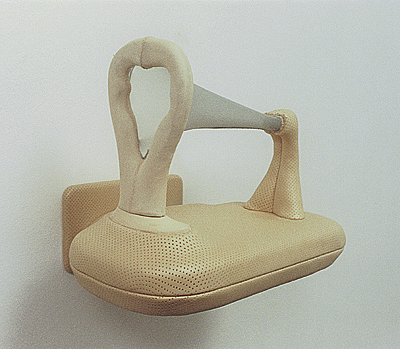| Zeitschrift Umělec 1997/6-7 >> City of the Deprived | Übersicht aller Ausgaben | ||||||||||||
|
|||||||||||||
City of the DeprivedZeitschrift Umělec 1997/6-701.06.1997 Lenka Lindaurová | rezension | en cs |
|||||||||||||
|
The zone between just until recently separated worlds - between East and West Berlin - is one huge construction site today. Some of the Communist boulevards still look quite cheerless and the TV tower at Alexanderplatz takes on subtle nostalgic cuteness. When visiting other parts of town, however, a visitor cannot quite distinguish between the two old worlds.
After fall of the Berlin wall, the Eastern part of the city turned into an avalanche of changes with the city administration heavily investmenting into culture. East Berlin attracted crowds of young people from all over the world to study, create, work or just hang out. At first glimpse it is obvious that it is not very difficult to find space for studios or galleries in Berlin. Deserted factories, transformer stations, courtyards, basements ... all pulsate with activity. Very typical for Berlin of the 90‘s is the mix of styles, snobbery next to underground (or underground-turned-snobbery), professionalism next to amateurism. Compared to the established gallery system of the slick West, the East’s openness and multinationality is quite refreshing. Underground became the big thing in Berlin of the 90‘s. All events - including the official ones - bore its attributes. The underground phenomenon got into the interest of philosophers and sociologists. Countless events and projects were organized in its name which caused that the term became a bit misleading. As if this promotion took away its independence. Yet the truth is that boudaries between the official and the unofficial are very blurred. If an honest critic were to precisely document exhibitions in all of Berlin’s little galleries, it would be hard to do. In Mitte alone there are at least 40 of them, each providing an updated schedule of all shows with a little map of this quarter. About every three months, Mitte galleries organize one huge group opening. At 5 p.m. on Saturday, all galleries open shop and crowds of people may wonder from one space to another. The open spaces accept nearly anything as if this intended unconceptuality was an important prerequisite of independence. Lacking continuous tracing of the galleries’ activities, it is rather hard to judge their program. Some of the spaces, however, stand out - either with style, manner of presentation or selection of artists (Eigen + Art Gallery, Arndt&Partner, Wohnmachine, Barbara Tumm, Klosterfelde). Hard-core underground galleries do not put much effort into their promotion which actually makes their openness ambivalent. In August, Wohnmachine Gallery was showing work by Florian Merkel who reflected everlasting issue of happy and wealthy society. His figurative scenes from lives of beautiful young people are painted on white canvases with thin colorful lines as if they were cartoons (only one painting is in „full color“). The cycle entitled Jugend und Technik precisely reflects deviated character of propaganda which may be conspicuously similar in various parts of the world. As false as socialist and capitalist utopia is the beauty of paintings. Eigen + Art Gallery showed a wide range of artists some of whom took part in this year’s documenta X (C. Hill, Y. Milev, C. Nicolai, O. Nicolay). The relaxed „non-gallery“ instalation presents mainly conceptual works such as Hand-made Baby by Christine Borland. Agile Arndt&Partner Gallery is located in the restaured Hackesche Höffe and showed Douglas Kolk (pale drawings on a wall) and Max Mohr (simulating objects). Barbara Thumm Gallery offered well-known names and their portrait pieces: Glenn Brown, Alex Katz, Catherine Yass. Matthew Antezzo was showing his rough canvases in Klosterfelde Gallery. With Nikolai Makarov’s canvases, Das Stille Museum feels to be out of another space. In addition to gallery presentation, works in Berlin are often anonymous - from an instalation of junk on the street to conceptual projects on empty wall spaces. Artists work in abandoned buildings such as old transformer station which is preparing absurdly official symposium of underground art. They already talk about what is and what isn’t underground, how to select participants and whether it should be a gigantic event or not. Basements and hallways of this spooky transformer station produce peculiar pieces which are impossible to define. Compared to Eastern galleries, their Western counterparts are nonsensically sterile: inside, one just whispers and gazes in contemplation at hundred times used and slick art. Franck+Schulte Gallery showed morbid giant photographs by Chuck Close and Tony Oursler’s videoproject. Quite fresh Neugerriemschneider Gallery, which mostly shows new trends, presented pictures and geometrical sofas by Tobias Rehberger. The strong opposition to all official expressions from Berlin’s totalitarian times now joins with young Westerners’ disappointment with commercialized culture. Sometimes this produces hybrid attitude of tattoed underground and at other times it develops a lively branch of artistic expressions free of preconceptions. (pages 20 through 21)
01.06.1997
Empfohlene Artikel
|
|||||||||||||













Kommentar
Der Artikel ist bisher nicht kommentiert wordenNeuen Kommentar einfügen